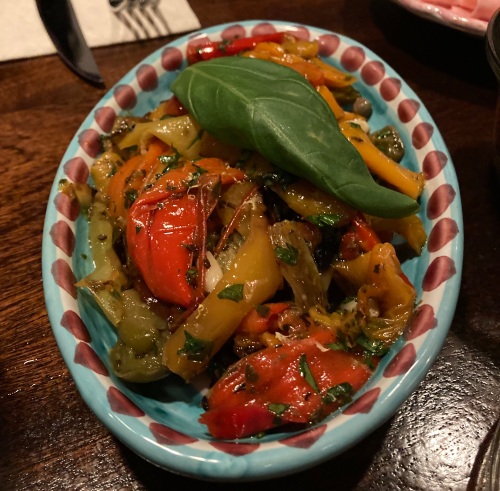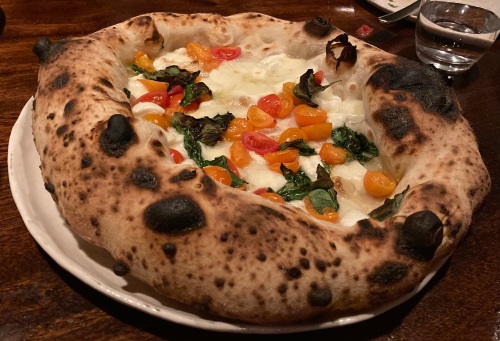I have known the dynamic Ilaria Petitto, CEO of Donnachiara Winery, for a number of years and have visited her winery on a few occasions. Recently Ilaria was in New York and invited me to a luncheon and tasting of her wines with the intriguing title of “Long Live Aglianico-Based Wines, Taurasi the King of Southern Italy.” The event was held at Gramercy Tavern in New York’s Flatiron District.
 Illaria is a leading supporter of the wines of Campania and the wines of Irpinia in particular and is the Vice President of the Consorzio di Tutela dei Vini dell’Irpinia. She is also involved with Women in Wine.
Illaria is a leading supporter of the wines of Campania and the wines of Irpinia in particular and is the Vice President of the Consorzio di Tutela dei Vini dell’Irpinia. She is also involved with Women in Wine.
Ilaria spoke about the Donnachiara Winery and their wines.
 The winery is located in Montefalcione in the Irpinia area near Avellino. There are woods of chestnut, oak and juniper that alternate with olive trees, vines and fruit trees.
The winery is located in Montefalcione in the Irpinia area near Avellino. There are woods of chestnut, oak and juniper that alternate with olive trees, vines and fruit trees.
The modern winery was completed in 2005 but the vineyards have been in the family for over 150 years. Ilaria’s mother, Chiara Petitto, is a big supporter of her work in the winery, which is named after her mother’s grandmother, whom everyone called “Donna” Chiara as a sign of respect. Modern production began in 2005 . Donnachiara is a family business
The consulting oenologist at this time is the legendary Riccardo Cotarella.
It is the philosophy of the winery to preserve the traditional grape varieties of the local territory and to keep the character of the wines from being lost to the standardization of the wines on the market today. They also follow “Misura CE n.1257/99 – “Produzione integrata della Regione Campania,” limiting the use of some active ingredients that are harmful to the environment.
 Agilianco
Agilianco
There are 3 biotypes of Aglianico: Taurasi, Vulture and Taburno. Aglianico has an uncle-nephew relationship to Syrah.
Aglianico is an ancient grape variety. In Italy, Aglianico was first planted near modern day Pozzuoli and from there it spread to other parts of Campania. Pliny the Elder (d.79AD) wrote about it in his Natural History. Wine made from Aglianico was called Falernian and was highly regarded by the Romans. The Aglianico grape was known as Elenico (Italian for Greek) until the 15 Century when it began to be called Aglianico. The name might also come from vita hellenica, Latin for Greek wine. The debate still goes on.
The Aglianico grape prefers volcanic soil and grows at altitudes of 300 to 500 meters. It is a black late-ripening grape. Aglianico is also used as a blending grape in Campania. It is at its best in Irpinia. Irpinia Aglianico was granted DOC in 2005. It must contain 85% Aglianico and 15% other red grapes.
 Greco di Tufo (yellow), Finao di Avelliano(green) and Taurasi (red). DOCG Irpinia
Greco di Tufo (yellow), Finao di Avelliano(green) and Taurasi (red). DOCG Irpinia
Taurasi
There are many who believe that the three great grape varieties in Italy are Nebbiolo, Sangiovese and Aglianico. Wines made from the Aglianico grape are full-bodied with good fruit, tannins, and hints of blackberries, leather and smoke.
Aglianico reaches its highest expression in the form of Taurasi, one of Italy’s great red wines, which can age for many years.
The Taurasi DOCG was formed in 1993 and was southern Italy’s first DOCG. Taurasi is a medieval city located within the larger Iripinia DOC and within the province of Avellino, Taurasi’s name comes from taurus, the mythical bull that was the symbol for the ancient Samnite (pre-Roman) occupants.
Taurasi DOCG and Taurasi Riserva DOCG by law must be 85% Aglianico but most producers make it with 100% Aglianico. Taurasi must age for 3 years before release and have a minimum of 12% alcohol. At least one of the 3 years must be in oak barrels. The Riserva must be aged for at least 4 years of which 18 months must be in oak barrels. 12.5% is the minimum alcohol.
There are 17 communes where Taurasi is produced and they cover different soils, vineyard altitudes and microclimates.
 Campania Aglianico IGT 2022 made from 100% Aglianico. The soil is clay, the training system is guyot and the harvest takes place in the first half of November. Malolatic fermentation takes place in barriques for 3 months. Ilaria said this is a fresh and pleasant wine due to a small number of “follature” (pumping overs) and to a short period of maceration on the skins. Malolactic fermentation is in barriques for 3 months. It is a wine that is elegant, warm and perfect with many different foods. The wine is fruity with hints of blackberries, strawberries and a touch of toast. This is a wine that should be drunk young.
Campania Aglianico IGT 2022 made from 100% Aglianico. The soil is clay, the training system is guyot and the harvest takes place in the first half of November. Malolatic fermentation takes place in barriques for 3 months. Ilaria said this is a fresh and pleasant wine due to a small number of “follature” (pumping overs) and to a short period of maceration on the skins. Malolactic fermentation is in barriques for 3 months. It is a wine that is elegant, warm and perfect with many different foods. The wine is fruity with hints of blackberries, strawberries and a touch of toast. This is a wine that should be drunk young.
 Irpinia Aglianico DOC 2021. The soil is clay, the training system is guyot and the harvest takes place the first two weeks in November. Fermentation takes place at 68 to 71F in stainless steel tanks for 15 days. Maturation is on the skins for 10 days. Malolactic fermentation is in barriques. The wine is full and complex with hints of prune, berries, spice and fig. Drink after 5 years or more.
Irpinia Aglianico DOC 2021. The soil is clay, the training system is guyot and the harvest takes place the first two weeks in November. Fermentation takes place at 68 to 71F in stainless steel tanks for 15 days. Maturation is on the skins for 10 days. Malolactic fermentation is in barriques. The wine is full and complex with hints of prune, berries, spice and fig. Drink after 5 years or more.
 Taurasi DOCG 2020 Made from 100% Aglianico. The soil is clay and volcanic. Training system is guyot. There are 4,000 plants per hectare and harvest takes place the first week of September. The wine is aged for 12 months in 225-liter French barriques and remains in the bottle for another 24 months before release. The use of barrique is subtle and does not mask the character of the wine. This is a big complex wine with berry aromas and flavors, hints of cherry, plum, and a touch of cacao and coffee. In general this vintage had a slightly lower crop than normal, but grapes were of good quality with nice acidity.
Taurasi DOCG 2020 Made from 100% Aglianico. The soil is clay and volcanic. Training system is guyot. There are 4,000 plants per hectare and harvest takes place the first week of September. The wine is aged for 12 months in 225-liter French barriques and remains in the bottle for another 24 months before release. The use of barrique is subtle and does not mask the character of the wine. This is a big complex wine with berry aromas and flavors, hints of cherry, plum, and a touch of cacao and coffee. In general this vintage had a slightly lower crop than normal, but grapes were of good quality with nice acidity.
Taurasi DOCG 2019 Made from 100% Aglianico. The soil is clay and volcanic. Training system is guyot. There are 4,000 plants per hectare and harvest takes place the first half of of November. The wine is aged for 12 months in 225-liter French barriques and remains in the bottle for another 24 months before release. The use of barrique is subtle and does not mask the character of the wine. This is a big complex wine with berry aromas and flavors, hints of blueberries, plum, bitter chocolate a touch of leather and a hint of smoke.
 Taurasi Riserva DOCG 2019 made from 100% Aglianico. The soil is clay, training system is guyot and the harvest takes place the first half of November. This wine is produced only in the best vintages. There is manual grape picking, a careful cluster selection followed by a soft pressing of the grapes. Maturation is on the skins for 20 days. Malolactic fermentation takes place in barriques. This is a full intense wine with hints of blackberry, blueberry a hint of smoke and coffee notes. It is on its way to becoming a great wine with a little more bottle age. The wine will last for at least 15 to 20 years.
Taurasi Riserva DOCG 2019 made from 100% Aglianico. The soil is clay, training system is guyot and the harvest takes place the first half of November. This wine is produced only in the best vintages. There is manual grape picking, a careful cluster selection followed by a soft pressing of the grapes. Maturation is on the skins for 20 days. Malolactic fermentation takes place in barriques. This is a full intense wine with hints of blackberry, blueberry a hint of smoke and coffee notes. It is on its way to becoming a great wine with a little more bottle age. The wine will last for at least 15 to 20 years.
2019 was an outstanding vintage with wonderful climatic conditions. There was a large crop and the wines have very good acidity.The wine has won many awards.
Taurasi Riserva DOCG 2018 made from 100% Aglianico. The soil is clay, training system is guyot and the harvest takes place the first half of November. This one is produced only in the best vintages. There is manual grape picking, a careful cluster selection followed by a soft pressing of the grapes. Maturation is on the skins for 20 days. Malolactic fermentation takes place in barriques. This is a wine with hints of blackberry, plum, cherry and coffee notes.
The wines 2018 in general are unbalanced, with low acidity and the harvest was very small in size. However I did not find this with the 2018 Donnachiara Taurasi. While it may not last as long as the 2019, I would not drink it for at least 10 to 12 years.
Donnachiara also produces excellent white wines: Greco di Tufo, Fiano di Avellino and Falanghina, all of which I have tasted and enjoyed on many occasions.
 We started with some appetizers including a salad of roasted peppers with garlic, capers, herbs and olive oil.
We started with some appetizers including a salad of roasted peppers with garlic, capers, herbs and olive oil. Pizza with mozzarella, cherry tomatoes and arugula was next.
Pizza with mozzarella, cherry tomatoes and arugula was next. All of the pizzas and appetizers are made with extra virgin olive oil imported from the Campania region of Italy.
All of the pizzas and appetizers are made with extra virgin olive oil imported from the Campania region of Italy. 







































